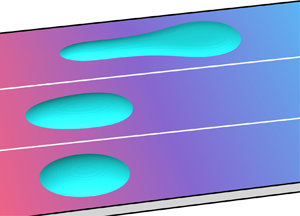Published online by Cambridge University Press: 29 March 2021

We investigate the dynamics of a self-rewetting drop placed on a substrate with a constant temperature gradient via three-dimensional numerical simulations using a conservative level-set approach to track the interface of the drop. The surface tension of a so-called self-rewetting fluid exhibits a parabolic dependence on temperature with a well-defined minimum. Two distinct drop behaviours, namely deformation and elongation, are observed when it is placed at the location of the minimum surface tension. The drop spreads slightly and reaches a pseudo-steady state in the deformation regime, while it continuously spreads until breakup in the elongation regime. Theoretical models based on the forces exerted on the drop have been developed to predict the critical condition at which the drop undergoes the transition between the two regimes, and the predictions are in good agreement with the numerical results. We also investigate the effect of the initial position of the drop with respect to the location of the minimum surface tension on the spreading and migration dynamics. It is found that, at early times, the migration of the drop obeys an exponential function with time, but it diverges at the later stage due to an increase in the drop deformation.